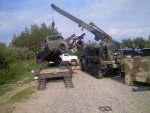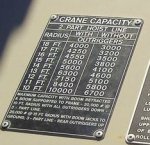- 12,195
- 319
- 0
- Location
- gainesville, ga.
Most of the guys that buy the military wreckers, buy then because they are cool, or to lift stuff, but have NEVER run a crane before,
So if you think you might need to set the outriggers for a lift, pull the needed ones ALL the way out and set them tight where they are taking the weight of the truck BEFORE you swing over them to pick the load, If you set them loose with the idea that if the truck leans over the outrigger will set up and take the load, WRONG, what happens is as the truck leans over, the load is moving OUT away from the truck, which in affect puts more weight on the boom, causing more lean, things can get bad in a hurry. One of the BAD things about a military wrecker crane is that all functions are powered, there is NO free fall, this means you can NOT get out from a load if you start to go over.
This may sound dumb but MAKE SURE where the out riggerpad is set will take the load, not the load of the truck BUT will support the crane load, once the pick is started or the load is swrung over the side it is to late to find out the ground will not support the load. Either reposition or use support pads under the outrigger pads, a nice 30" x 30" pad, 4" to 6" would be about right. does not do any good to throw rock under the outrigger pad if there is nothing worth a crap under the rock.
When you are doing a pick, boom up just a bit so when you take the load, the boom deflection will put the hook back over the load, if you do not boom up a bit, the boom deflection WILL move the load away from the crane, this can cause broke stuff, smashed fingers, even tip the crane over on right at to edge lifts, the heavier the lift, the more boom up is needed to counter act the boom deflection. No matter how well the truck is set, you will STILL get boom deflection.
Mods THANK YOU
So if you think you might need to set the outriggers for a lift, pull the needed ones ALL the way out and set them tight where they are taking the weight of the truck BEFORE you swing over them to pick the load, If you set them loose with the idea that if the truck leans over the outrigger will set up and take the load, WRONG, what happens is as the truck leans over, the load is moving OUT away from the truck, which in affect puts more weight on the boom, causing more lean, things can get bad in a hurry. One of the BAD things about a military wrecker crane is that all functions are powered, there is NO free fall, this means you can NOT get out from a load if you start to go over.
This may sound dumb but MAKE SURE where the out riggerpad is set will take the load, not the load of the truck BUT will support the crane load, once the pick is started or the load is swrung over the side it is to late to find out the ground will not support the load. Either reposition or use support pads under the outrigger pads, a nice 30" x 30" pad, 4" to 6" would be about right. does not do any good to throw rock under the outrigger pad if there is nothing worth a crap under the rock.
When you are doing a pick, boom up just a bit so when you take the load, the boom deflection will put the hook back over the load, if you do not boom up a bit, the boom deflection WILL move the load away from the crane, this can cause broke stuff, smashed fingers, even tip the crane over on right at to edge lifts, the heavier the lift, the more boom up is needed to counter act the boom deflection. No matter how well the truck is set, you will STILL get boom deflection.
Mods THANK YOU
Last edited:







